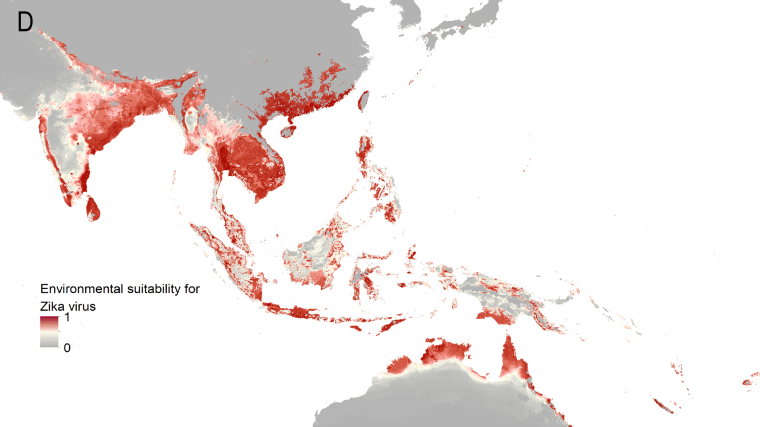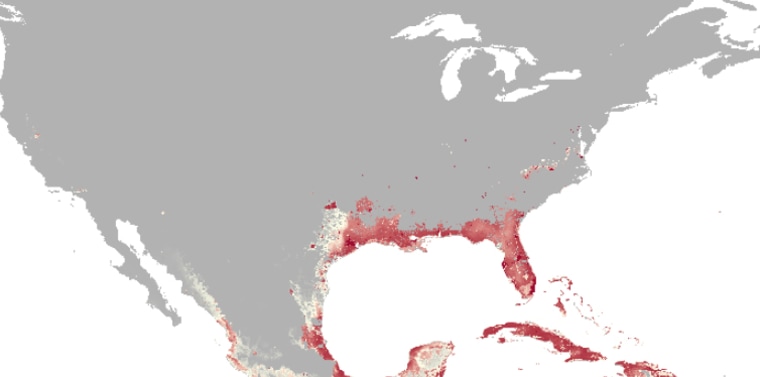A new global map calculating when and where Zika virus is likely to spread shows 2 billion people could be in the Zika zone.
Nearly 300 million people in the Americas live in areas where the mosquitoes that spread Zika thrive, and more than 5 million babies a year are born to women living in these areas, the team at the University of Washington, Oxford University and elsewhere report in the journal ELife.
“Globally, we predict that over 2.17 billion people live in areas that are environmentally suitable for Zika virus transmission,” they wrote.

“Although Zika virus has yet to be reported in the USA, a large portion of the southeast region of the country, including much of Texas through to Florida, is also highly suitable for transmission,” they added.
“It’s a fair strip all the way across that coastline from Texas to Florida,” said David Pigott of the University of Washington’s Institute for Health Metrics and Evaluation, who worked on the study.
And lots of babies will be born in the vulnerable areas over the next year.
“We also estimate that 5.42 million births will occur in the Americas over the next year within areas and times of environmental suitability for Zika virus transmission,” the team wrote.
The good news for the U.S. is that even though the mosquitoes that carry Zika can be found as far north as New York and San Francisco, in many areas the populations don’t circulate for enough days every year to make it likely Zika will build up in the insects and in the people they bite.
“It’s a fair strip all the way across that coastline from Texas to Florida."
The team put together the global maps based on where Aedes aegypti mosquitoes, which spread Zika, are common. They also looked at where people live in densely populated or urban areas with enough moisture and vegetation for the mosquitoes to thrive.
“It is not the presence of Aedes aegypti that that is the most concerning thing. It is the establishment of the population there that allows for transmission to occur,” Pigott told NBC News.
These are not the first maps to look at where Zika might spread, but they’re the most detailed global predictions yet, the team said.
Zika has spread fast already across Brazil, Colombia, Venezuela, central America and the Caribbean. The World Health Organization says 42 countries are experiencing their first outbreaks of Zika virus since 2015.
Doctors are alarmed by the steep rise in birth defects, as well as an increase in cases of paralyzing and other nerve conditions, including Guillain Barré syndrome, in patients.
The Centers for Disease Control and Prevention and the World Health Organization have warned pregnant women to stay away from active Zika areas, if at all possible. Everyone in Zika zones, they say, should protect themselves from mosquito bites with repellents such as DEET, clothing and by staying indoors.
“The maps we have presented may also inform existing travel advisories for pregnant women and other travelers,” the researchers wrote.
Related: Health Officials Ask Congress for Cash to Fight Zika
For instance, it’s becoming clear that higher elevations and drier areas may be safer.
The CDC has said it’s easy to predict where Zika will spread, just by looking at where its close cousins, chikungunya and dengue virus, are spreading. They’re carried by the same mosquitoes.
Pigott says this study adds more data on where Zika’s actually been seen and takes into account differences in how dengue, chikungunya and Zika all spread.
The occasional human case — as when a traveler comes home infected — is not enough to spark an outbreak unless the Aedes aegypti mosquitoes are also breeding in the area for at least 350 days a year, the researchers said.
“Large portions of the Americas are suitable for transmission, with the largest areas of risk occurring in Brazil."
And people need to be exposed to those mosquitoes. Air-conditioned homes with screens are not good homes for any mosquitoes.
Earlier this year, a team at the National Center for Atmospheric Research projected that New York, Philadelphia and Washington D.C. have a moderate risk of Zika outbreaks.
They said low-risk cities include dry, high-altitude places such as Denver, Albuquerque and Salt Lake City.
The newest maps show India, southeast Asia and the northern coast of Australia are also high-risk places.
“Large portions of the Americas are suitable for transmission, with the largest areas of risk occurring in Brazil, followed by Colombia and Venezuela, all of which have reported high numbers of cases in the 2015-2016 outbreak,” the team wrote.
“In Brazil, where the highest numbers of Zika virus are reported in the ongoing epidemic, the coastal cities in the south as well as large areas of the north are identified to have the highest environmental suitability of Zika virus.”
But central Brazil is less vulnerable, the model shows.
Another team made similar predictions. Abdallah Samy of the University of Kansas and colleagues used similar methods to predict Zika's global spread.
"Our models corroborated Zika virus's large-scale potential for expansion in South and Central America, and identifies other regions at risk of Zika transmission, particularly Sub-Saharan Africa, Australia, Melanesia, and parts of New Zealand," they reported to Brazil's national medical institute's journal.
"Northern Australia is at risk as a function of vector availability and environmental suitability, but less so based on human conditions. Other at-risk regions include Angola, Zambia, the Amazon Basin, and northern South America," they added.
Most experts believe the explosive spread will eventually slow as more people become immune to the virus. That means fewer people with active infections will be around to get bitten by mosquitoes, which means fewer mosquitoes can pick up the virus to carry it to others.

